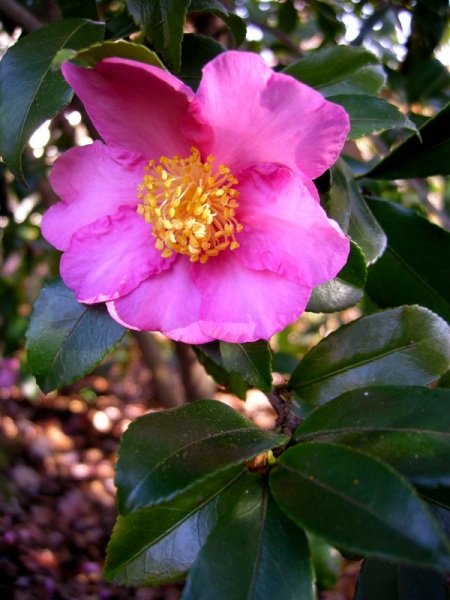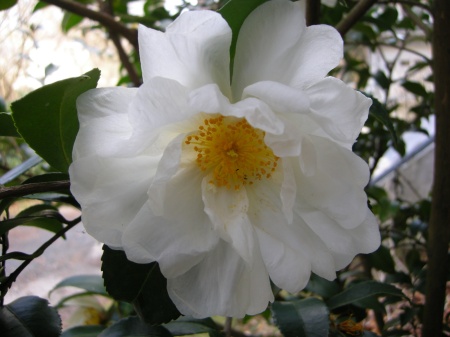Carolyn’s Shade Gardens is a retail nursery located in Bryn Mawr, PA, specializing in showy, colorful, and unusual plants for shade. The only plants that we ship are snowdrops and miniature hostas. For catalogues and announcements of events, please send your full name, location, and phone number (for back up use only) to carolyn@carolynsshadegardens.com. Click here to get to the home page of our website for catalogues and information about our nursery and to subscribe to our blog.
 Spring-blooming camellia ‘Spring’s Promise’ is available in the current offer but was profiled in a previous woody plant post so I am not describing it here. However, it is a favorite of mine, and I wanted to include a photo. For a full write up of this plant, go to Woody Plants for Shade Part 1.
Spring-blooming camellia ‘Spring’s Promise’ is available in the current offer but was profiled in a previous woody plant post so I am not describing it here. However, it is a favorite of mine, and I wanted to include a photo. For a full write up of this plant, go to Woody Plants for Shade Part 1.
.
My nursery, Carolyn’s Shade Gardens, specializes in perennials for shade with an emphasis on hellebores, unusual bulbs especially snowdrops, hostas particularly miniature hostas, native plants, and ferns. However, a satisfying shade garden does not consist of just perennials but includes trees, shrubs, and vines. I provide a quality source for these plants by doing a special offer three times a year.
I have just sent my first 2013 list to my customers. To view the catalogue, click here. However, I thought my blog readers who are not customers might be interested in learning about the woody plants that I would recommend they add to their shade gardens. And doing an article allows me to add more information and explain why I chose the plants I included so customers might be interested also.
.
 Spring-blooming camellia ‘Korean Fire’ has the most beautiful leaves of any camellia.
Spring-blooming camellia ‘Korean Fire’ has the most beautiful leaves of any camellia.
The offer focuses on winter- and early spring-blooming plants, evergreens and winter interest, native plants, and fragrance. Included are four camellias, six other shrubs, and one vine. Six of the plants I have chosen are evergreen, and seven bloom off season, in fall or late winter/early spring. This reflects my desire to see gardeners expand their gardens’ season beyond spring and summer to become a year round paradise for them to enjoy. With that introduction, here are the plants I am highlighting:
I included four hardy camellias for their spectacular early (or late) season flowers and elegant evergreen leaves. These camellias, along with many other cultivars, have been selected to be fully cold hardy in the mid-Atlantic U.S, zones 6B and 7A. Nevertheless all camellias benefit from being sited to shelter them from winter wind, which comes from the northwest. They also maintain their lustrous dark green leaves in better shape if they are sheltered from winter sun.
‘Korean Fire’ is a Camellia japonica cultivar hardy in our area because it was selected from the most northern range of the species. It has very showy bright red single flowers in April and May and glossy dark evergreen leaves. It grows to 10′ tall and 6′ wide in part to full shade. It was introduced by Barry Yinger of Asiatica Nursery from plants collected in Korea in 1984 and has received the Pennsylvania Horticultural Society Gold Medal Award for outstanding plants for our area.
.
 ‘April Rose’ spring-blooming camellia
‘April Rose’ spring-blooming camellia
Camellia x ‘April Rose’ is a spring-blooming hardy camellia with gorgeous plump buds opening to formal double rose-pink flowers in April and May. It has large glossy dark evergreen leaves. It is 5’ tall and 4′ wide, growing in part to full shade. It is part of the April series of exceptionally cold hardy camellias developed by Dr. Clifford Parks of North Carolina.
.
 Fall-blooming camellia ‘Winter’s Star’
Fall-blooming camellia ‘Winter’s Star’
‘Winter’s Star’ is a fall-blooming, cold hardy camellia with single pink flowers in October and November and glossy evergreen leaves. It is a vigorous plant with an upright habit, reaching 6′ tall and 5′ wide at maturity and sporting lustrous dark evergreen leaves in part to full shade. It was selected for cold hardiness by Dr. William Ackerman at the U.S. National Arboretum in Washington, DC.
.
 ‘Sasaba’ holly osmanthus (also known as holly tree olive), O. heterophyllus, blooms in the fall and is beautifully fragrant.
‘Sasaba’ holly osmanthus (also known as holly tree olive), O. heterophyllus, blooms in the fall and is beautifully fragrant.
Fall-blooming holly osmanthus‘Sasaba’ is the fifth evergreen in the offer, and I would grow it just for its dramatic, deeply incised dark evergreen leaves. Its delicious fragrance perfumes my whole hillside in November when it blooms: if you are visiting you can see it on the back hill. Its prickly foliage repels deer. It grows 6’ tall and 4’ wide in full sun to full shade.
.
 Japanese mahonia, Mahonia japonica, is the sixth evergreen in the offer. It was previously profiled here, but I am including it again because I think it is the most fragrant and best all round mahonia species.
Japanese mahonia, Mahonia japonica, is the sixth evergreen in the offer. It was previously profiled here, but I am including it again because I think it is the most fragrant and best all round mahonia species.
.
There are four deciduous shrubs in the offer:
 ‘Texas Scarlet’ flowering quince, Chaenomeles x superba, is another repeat. This compact selection gives you the wonderful early flowers of quince without the lethal thorns and out-of-control growth habit of normal quinces. For a complete profile, click here.
‘Texas Scarlet’ flowering quince, Chaenomeles x superba, is another repeat. This compact selection gives you the wonderful early flowers of quince without the lethal thorns and out-of-control growth habit of normal quinces. For a complete profile, click here.
.
 The lovely fragrant flowers of fothergilla.
The lovely fragrant flowers of fothergilla.
.
 This is a photo of my unselected fothergilla so I can only imagine what ‘Red Licorice’ must look like in the fall.
This is a photo of my unselected fothergilla so I can only imagine what ‘Red Licorice’ must look like in the fall.
.
Native ‘Red Licorice’ fothergilla has honey-scented, white bottlebrush flowers in April and May. It is a new fothergilla cultivar selected for its spectacular cherry red fall color. It grows to 6’ tall and 5’ wide in full sun to full shade. It is wet site tolerant, deer resistant, and attracts butterflies. It is native to the southeastern US.
.
 ‘Golden Guinea’ Japanese kerria, Kerria japonica, produces copious amounts of large, bright gold flowers.
‘Golden Guinea’ Japanese kerria, Kerria japonica, produces copious amounts of large, bright gold flowers.
.
 A close up of ‘Golden Guinea’
A close up of ‘Golden Guinea’
.
‘Golden Guinea’ Japanese kerria is covered with 2 ½” yellow flowers in April and May and then reblooms sporadically. It has delicate, bright green pointed leaves, and its graceful stems are a vibrant green providing great winter interest. It grows to 5’ tall and 4’ wide in part sun to almost full shade (full sun bleaches the flowers). Kerria grows in average garden soils, is tough and adaptable, and resists deer.
.
 The lovely buds of native sweet azalea, Rhododendron arborescens.
The lovely buds of native sweet azalea, Rhododendron arborescens.
.
 The fragrant flowers of sweet azalea.
The fragrant flowers of sweet azalea.
.
Native sweet azalea’s very attractive buds, which are on the plant right now, produce light pink to white very fragrant flowers with showy red stamens from May to June. Its lustrous green leaves turn a stunning orange to red in fall. It can grow to 10’ tall and 7’ wide in full sun to almost full shade but is usually smaller. Sweet azalea is wet site tolerant and is one of Pennsylvania’s hardiest native deciduous azaleas. It was first described by John Bartram in 1814.
.
 Carolina jessamine ‘Margarita’, Gelsemium sempervirens, is a vine that I have offered before but its many fragrant, bright yellow flowers, semi-evergreen leaves, and the fact that it is native to the southeastern US make it a very desirable plant. For a complete profile, click here. Photo courtesy of the Missouri Botanical Garden PlantFinder.
Carolina jessamine ‘Margarita’, Gelsemium sempervirens, is a vine that I have offered before but its many fragrant, bright yellow flowers, semi-evergreen leaves, and the fact that it is native to the southeastern US make it a very desirable plant. For a complete profile, click here. Photo courtesy of the Missouri Botanical Garden PlantFinder.
.
I grow most of these plants in my gardens so I know you can’t go wrong by adding them to yours! If you are a customer, see Nursery Happenings below for details on how to order these wonderful shade plants by noon on March 30. If not, now you have some plants to ask for at your local independent nursery.
Carolyn
.
Carolyn’s Shade Gardens is a retail nursery located in Bryn Mawr, Pennsylvania, US, zone 6b. The only plants that we mail order are snowdrops and miniature hostas and only within the US.
If you are within visiting distance and would like to receive catalogues and information about customer events, please send your full name and phone number to carolynsshadegardens@verizon.net. Subscribing to my blog does not sign you up to receive this information.
Nursery Happenings: The nursery is open and fully stocked. If you can’t come to an event, just email to schedule an appointment to shop. If you wish to order shrubs, everything you need to know is in the catalogue, which can be accessed here. The deadline for shrub orders is noon on March 30. Our Native Wildflower Weekend takes place on Friday, April 5, from 10 am to 4 pm, and Saturday, April 6, from 10 am to 2 pm. If you are a customer, expect an email shortly with all the details.
Facebook: Carolyn’s Shade Gardens has a Facebook Page where I post single photos, garden tips, and other information that doesn’t fit into a blog post. You can look at my Facebook page here or click the Like button on my right sidebar here.
Notes: Every word that appears in orange on my blog is a link that you can click for more information. If you want to return to my blog’s homepage to access the sidebar information (catalogues, previous articles, etc.) or to subscribe to my blog, just click here.























